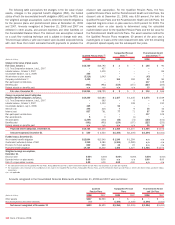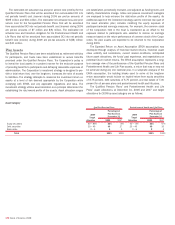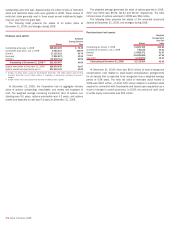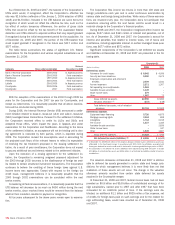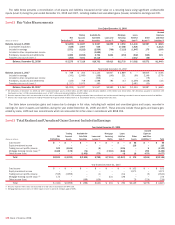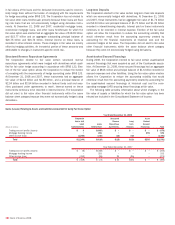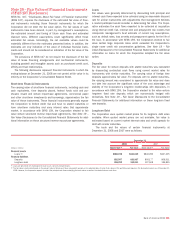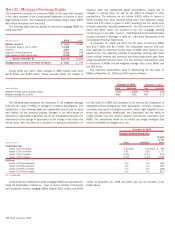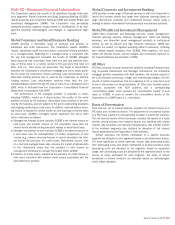Bank of America 2008 Annual Report Download - page 177
Download and view the complete annual report
Please find page 177 of the 2008 Bank of America annual report below. You can navigate through the pages in the report by either clicking on the pages listed below, or by using the keyword search tool below to find specific information within the annual report.
Note 19 – Fair Value Disclosures
Effective January 1, 2007, the Corporation adopted SFAS 157, which
provides a framework for measuring fair value under GAAP. SFAS 157
also eliminated the deferral of gains and losses at inception of certain
derivative contracts whose fair value was not evidenced by market
observable data. SFAS 157 requires that the impact of this change in
accounting for derivative contracts be recorded as an adjustment to
beginning retained earnings in the period of adoption.
The Corporation also adopted SFAS 159 on January 1, 2007. SFAS
159 allows an entity the irrevocable option to elect fair value for the initial
and subsequent measurement for certain financial assets and liabilities
on a contract-by-contract basis, with changes in fair value recognized in
earnings as they occur. The Corporation elected to adopt the fair value
option for certain financial instruments on the adoption date. SFAS 159
requires that the difference between the carrying value before election of
the fair value option and the fair value of these instruments be recorded
as an adjustment to beginning retained earnings in the period of adop-
tion.
The following table summarizes the impact of the change in account-
ing for derivative contracts described above and the impact of adopting
the fair value option for certain financial instruments on January 1, 2007.
Amounts shown represent the carrying value of the affected instruments
before and after the changes in accounting resulting from the adoption of
SFAS 157 and SFAS 159.
Transition Impact
(Dollars in millions)
Ending Balance
Sheet
December 31, 2006
Adoption Net
Gain/(Loss)
Opening Balance
Sheet
January 1, 2007
Impact of adopting SFAS 157
Net derivative assets and liabilities
(1)
$7,100
$ 22 $7,122
Impact of electing the fair value option under SFAS 159
Loans and leases
(2)
3,968
(21) 3,947
Accrued expenses and other liabilities
(3)
(28)
(321) (349)
Loans held-for-sale
(4)
8,778
– 8,778
Available-for-sale debt securities
(5)
3,692
– 3,692
Federal funds sold and securities purchased under agreements to resell
(6)
1,401
(1) 1,400
Interest-bearing deposit liabilities in domestic offices
(7)
(548)
1 (547)
Cumulative-effect adjustment, pre-tax (320)
Tax impact 112
Cumulative-effect adjustment, net-of-tax, decrease to retained earnings $(208)
(1) The transition adjustment reflects the impact of recognizing previously deferred gains and losses as a result of the rescission of certain requirements of EITF 02-3 in accordance with SFAS 157.
(2) Includes loans to certain large corporate clients. The ending balance at December 31, 2006 and the transition adjustment were net of a $32 million reduction in the allowance for loan and lease losses.
(3) The January 1, 2007 balance after adoption represents the fair value of certain unfunded commercial loan commitments. The December 31, 2006 balance prior to adoption represents the reserve for unfunded lending
commitments associated with these commitments.
(4) No transition adjustment was recorded for the loans held-for-sale because they were already recorded at fair value pursuant to lower of cost or market accounting.
(5) Changes in fair value of these AFS debt securities resulting from foreign currency exposure, which is the primary driver of fair value for these securities, had previously been hedged by derivatives that qualified for fair
value hedge accounting in accordance with SFAS 133. As a result, there was no transition adjustment. Following the election of the fair value option, these AFS debt securities have been transferred to trading account
assets.
(6) Includes structured reverse repurchase agreements that were hedged with derivatives in accordance with SFAS 133.
(7) Includes long-term fixed rate deposits that were economically hedged with derivatives.
SFAS 157 defines fair value as the exchange price that would be
received for an asset or paid to transfer a liability (an exit price) in the
principal or most advantageous market for the asset or liability in an
orderly transaction between market participants on the measurement
date. The Corporation determines the fair values of its financial instru-
ments based on the fair value hierarchy established in SFAS 157 which
requires an entity to maximize the use of observable inputs and minimize
the use of unobservable inputs when measuring fair value. The standard
describes three levels of inputs that may be used to measure fair value.
The Corporation carries certain corporate loans and loan commitments,
LHFS, structured reverse repurchase agreements, and long-term deposits
at fair value in accordance with SFAS 159. The Corporation also carries at
fair value trading account assets and liabilities, derivative assets and
liabilities, AFS debt securities, MSRs, and certain other assets. For a
detailed discussion regarding the fair value hierarchy and how the Corpo-
ration measures fair value, see Note 1 – Summary of Significant Account-
ing Principles to the Consolidated Financial Statements.
Fair Value Measurement
Level 1, 2 and 3 Valuation Techniques
Financial instruments are considered Level 1 when valuation can be
based on quoted prices in active markets for identical assets or
liabilities. Level 2 financial instruments are valued using quoted prices for
similar assets or liabilities; quoted prices in markets that are not active;
or models using inputs that are observable or can be corroborated by
observable market data of substantially the full term of the assets or
liabilities. Financial instruments are considered Level 3 when their values
are determined using pricing models, discounted cash flow method-
ologies or similar techniques and at least one significant model assump-
tion or input is unobservable and when determination of the fair value
requires significant management judgment or estimation.
The Corporation also uses market indices for direct inputs to certain
models, where the cash settlement is directly linked to appreciation or
depreciation of that particular index (primarily in the context of structured
credit products). In those cases, no material adjustments are made to
the index-based values. In other cases, market indices are also used as
inputs to valuation, but are adjusted for trade specific factors such as
rating, credit quality, vintage and other factors.
Corporate Loans and Loan Commitments
The fair values of loans and loan commitments are based on market
prices, where available, or discounted cash flows using market-based
credit spreads of comparable debt instruments or credit derivatives of the
specific borrower or comparable borrowers. Results of discounted cash
flow calculations may be adjusted, as appropriate, to reflect other market
conditions or the perceived credit risk of the borrower.
Bank of America 2008
175





